My botanical survey takes place along the Olentangy Bike Trail near Neil Ave. Apartments. The map below indicates the site that I deeply investigated. The edge of the recreational field was my starting point, and I ended my plant walks before reaching the Dodridge St bridge. Since the area that I investigated is located right next to the Olentangy River, this flat area is adjacent to the river. The site is located in its floodplain where I was able to identify a variety of plants species. I was not only able to found some very interesting perennial plants that tolerate flooded areas but I saw various species of animals. The plant community on this area is large varying. Due to the Olentangy River, plant’s of stream bank communities as well as plant’s of wooded areas appear here.
You can see the map, here:

American Hornbeam
The American Hornbeam , the Carpinus caroliniana, the Eastern North American plant is a medium size tree (around 20 to 40 feet) that is resistant to most pests and diseases. It didn’t take me too much to identify because it has short, twisted trunk with spreading crooked branches that form a dense vase-shaped canopy. The plant’s leaves have almost a bluish grey bark and ovate pointed leaves with finely toothed edges, and plated appearance. These leaves are alternate simple leaves.
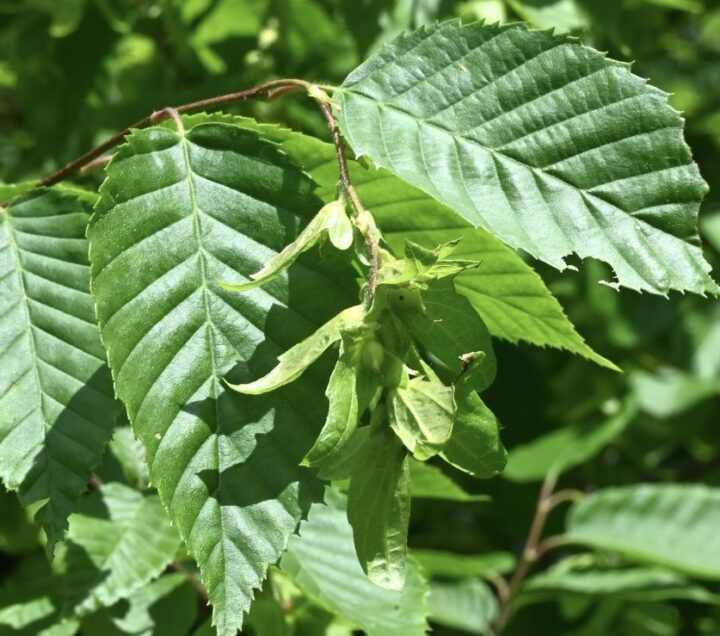
The artcile “All Species have Value” mentions an an interesting facts about the American Hornbeam. This plant is also called as ironwood and muscle-wood because of its wood. Due to its dense, strong iron-like wood people tend to call the American Hornbeam as ironwood. Others call this medium size tree as muscle tree because it has smooth grey bark which is often rippled like muscle.
Black Locust (Robinia pseudoacacia)
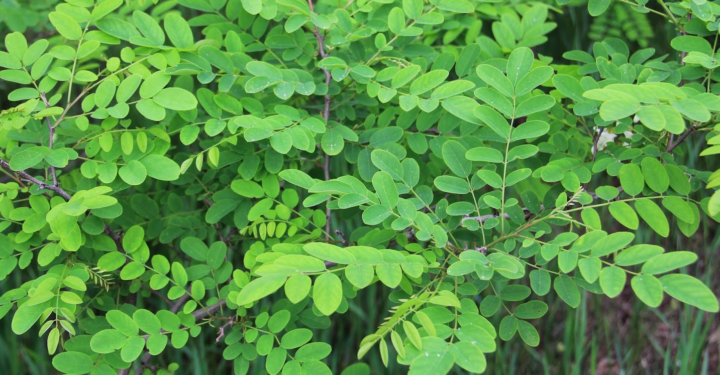
Black Locust alternate pinnate leaves
The next plant I would like to mention is called the Black Locust, Robinia pseudoacacia. Interestingly, this plant has invasive traits that enable them to spread aggressively. The black Locust is a medium sized hardwood deciduous tree with an average size of (30-50 ft). The leaf of the Black Locust is alternate pinnate with 9-29 oblong shape leaflets. This plant tolerates a soil pH range of 4.6-8.2 and usually grows in not too wet areas. The article “Biochar: Preparation, Properties and Applications in Sustainable Agriculture“, mentions that Black Locust is a prefect tree to plant in areas where eroison happened. In the past, this plant was used to help to increase the rate of land reclamation. Furthermore, it is perfect to control durable hardwood that grows extremely fast.
Canada Moonseed (Menispermum canadense)
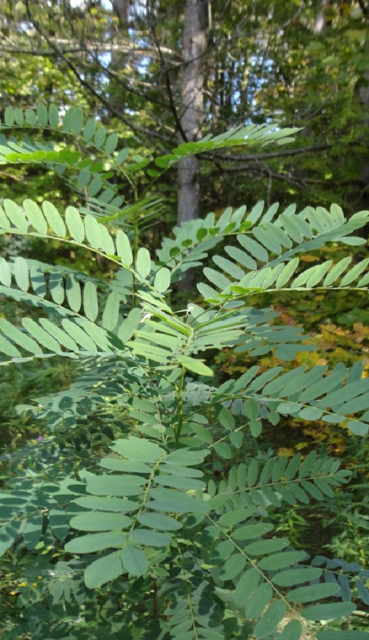
The Canada Moonseed Vine, Menispermum canadense, is a twining vine with stems that can reach 17 feet long or more. It climbs and sprawls on almost every statewide areas. Interestingly, its fruits are poisonous and resemble those of wild grapes. It occurs in thickets, moist woods, and the banks of streams. Therefore, it is important not to confuse this plant with grapes. The article “Three Times a Collection: The Quest for Moonseed” gives a detailed description of the fruit of the Canada Moonsweed. The fruits consists of clusters of bluish-black fruits and its seeds are flattened. The vine’s leaves are alternate, simple, and triangular which can reach 2-6 inches length. The Canada Moonseed’s steams are slender, twining, and reddish brown color. Furthermore, bark is brown and somewhat woody near the base.
Riverbank Grape
The Riverbank Grape, Vitis riparia, is afast growing, climbing, or trailing vine in the Vitaceae family that can grow up to 75 feet long. I found this plant as it grow over tree trunks and even climb up into the canopy of trees by use of its tendrils. It was easy for me to identify this vine because it has a reddish-brown bark that shreds into narrow strips. Most importantly, it has heart shaped. three lobed leaves with toothed margins. Furthermore, its leaves are alternate, simple and its leaf petioles are red.  Interestingly, the article “The dune race of Vitis riparia in Ontario: Taxanomy conservation and biogeography” mentions that the Riverbank Grape leaves are edible. Some people like to use them and eat them in a salad because they have a tangy citrus like taste while others might cook it. In the Mediterranean, the grape leaves are stuffed with rice, some sort of meat, and spices.
Interestingly, the article “The dune race of Vitis riparia in Ontario: Taxanomy conservation and biogeography” mentions that the Riverbank Grape leaves are edible. Some people like to use them and eat them in a salad because they have a tangy citrus like taste while others might cook it. In the Mediterranean, the grape leaves are stuffed with rice, some sort of meat, and spices.
Tall Boneset
I had a very hard time with the identification of the Tall Boneset, Eupatorium altissimum, becasue it extremely similar to the Late boneset (E.serotinum) plant. The Tall Boneset is abround 3 to 6.5 inch tall, perennial forb that rises on a single stem or pair of stems from a short caudex. Its stems are erect, sparsely branched near the top, and leafy.The leaves are mostly opposite, widely spaced, to 5 inches long. I also found teeth like structures above the middle of leaves. Its stems are covered with white hairs, and the flowers are dull white.
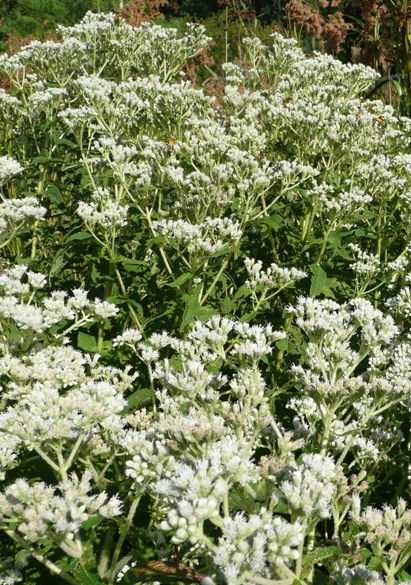
The Tall Boneset’s opposite leaves and dull white flowers.
Yellow Jewelweed
The last flowering plant that I identified is the Impatients pallida which is also known as “touch me not”. The plant got its name as it produces seed pods that harmlessly explode when touched, sending the seeds flying through the air. It is a tall leafy plant with succulent, translucent steams bearing nooding, mostly with yellow flower. Its leaves are oval shaped, pale green up to 4″long and 2″ across with serrated edges and long slender stalks that are arranged alternately on the stem.Interestingly, it is safe to eat the seeds of touch me not, they tastes similar to walnuts. The touch me not’s flowers usually appear in mid summer and can last until early fall.
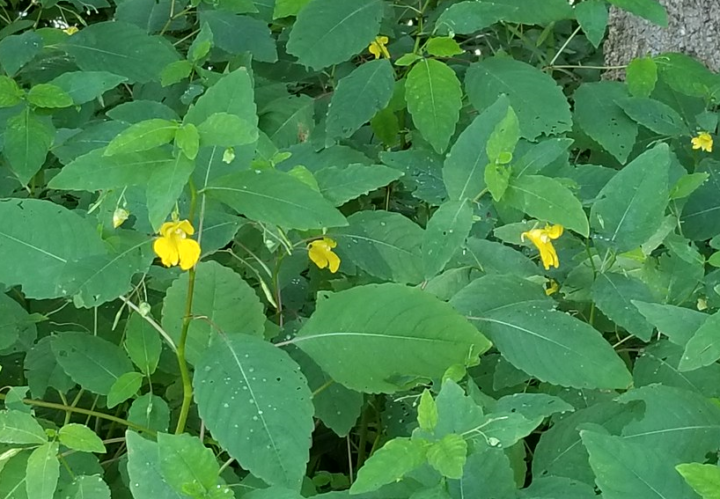
Poison Ivy
Last but not least, I was able to identify the Poison Ivy, Toxicodendron radicans, which is an allergenic plant in the genus Toxicodendron native to Asia and North America. The Poison Ivy prefers rich soil with good drainage and plenty of water. It is a vine plant type with small flowers that are yellowish-green and borne in clusters. Its leaf is deciduous, alternate, compound with 3 leaflets. These leaflets are ovate and irregularly toothed. They are usually shiny green above and paler below. The Poison Ivy is typically reddish in the fall, while green to yellow the remainder of the year. I found it easy to identify this plant after the catchy phrase “leaves of three let it be”. 
Botanical Survey Addition:
Part one: 20 species that I have found so far at my site, along with CC values for each.
- Black Locust (Robinia pseudoacadia), 0
- Tulip Tree (Liriodendron tulipfera), 6
- Poison Ivy (Toxicodendron radicans), 1
- American Basswood (Tilia americana), 6
- Ohio Buckeye (Aesculus glabra), 6
- Riverbank Grape (Vitis riparia), 3
- Eastern Redbud (Cercis canadensis),3
- Black Cherry (Prunus serotina), 3
- Tulip Tree (Liriodendron tulipfera), 6
- Virginia Creeper (Parthenocissus quinquefolia),2
- American Hackberry (Celtis occidentalis), 4
- American Sycamore (Platanus occidentalis), 7
- Tall Boneset, (Eupatorium altissimum), 0
- Wood-nettle (Laportea canadensis), 5
- Honey Locust (Gleditsia triacanthos), 4
- Black Walnut (Juglans nigra), 5
- Wingstem (Verbesina alternifolia), 5
- Swamp rose (Rosa palustris), 5
- Bur oak (Quercus macrocarpa) , 6
- Honey locust (Gleditsia triacanthos), 4
- American Hornbeam (Carpinus caroliniana), 5
- Common greenbrier (Smilax rotundifolia), 4
The FQAI for the Olitengy River Trail this is the Floristic Quality Assessment Index and I used the formula given in Andreas et al. (2004). The calculated FQAI for this particular site is 19.1.The number that I got is from adding up the CC numbers of the plants that I came across at the Olitengy River Trail and then divided by the square root of the sample size. Since my calculations gave me 19.1, this number indicates a low vegetative quality. Usually low vegetative quality is indicated by a number between 1-19.
Four of my highest CC species:
American Basswood (Tilia americana), 6

American basswood is a stately wide-spreading tree, 60-80 ft. tall. It has wide variety of environmental requirements which possibly accounts for its higher CC value. For instance, deep, fertile well-drained soil texture, and soil pH around 5.5-7.5. The leaves of the American Basswood have a distinctive heart shape, and notched, uneven bases. Moreover, they have serrated edges and end in a pointed tip. In addition, they are alternately arranged. Basswood twigs grow in a zig-zag pattern and can be green, red, or brown in color. The buds, like the twigs, can be green or red. The bark on an American basswood tree tends to be gray or brown with shallow. Interesting fact, according to “American Basswood” Native Americans used the fibrous inner bark for making rope, thongs, baskets, and mats.
Ohio Buckeye (Aesculus glabra), 6
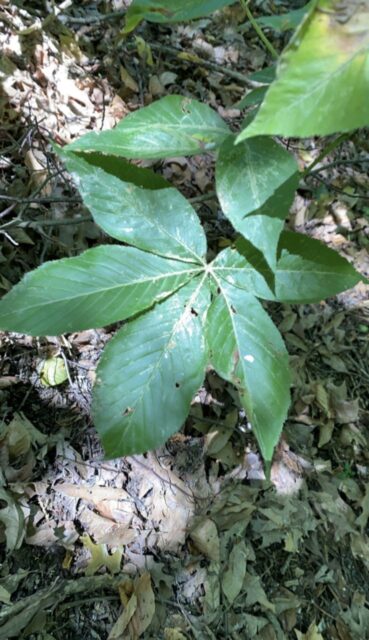
This plant is an attractive tree often recognized by its rounded canopy and thick, deeply fissured, gray bark. Interestingly, the Ohio buckeye superficially resembles horse-chestnut with its showy spires of white flowers and palmate leaves, 4-6 inch long, but its flowers have only 4 petals, not 5. This tree is valued for its early, showy spring flowers and for the equally early and striking orange and yellow color. The reason behind the larger CC value is due to the plant’s habitat preference. The buckeye is a moist-site tree and is most frequently found along river bottoms and in streambank soils. It is often found on moist soils. Thus, Ohio buckeye’s natural range extends from Ohio and western Pennsylvania to parts of Alabama, and westward to areas of Kansas, Nebraska, and Iowa. Interestingly, this plant Buckeyes can be used for medicinal purposes. According to the article “Tissue Culture Response of Ornamental and Medicinal Aesculus Species” after removal of the poisonous compound esculin, extracts can be made from the leaves and fruits of the buckeye to help people with joint pains, intestinal issues, and maladies.
American Sycamore (Platanus occidentalis), 7
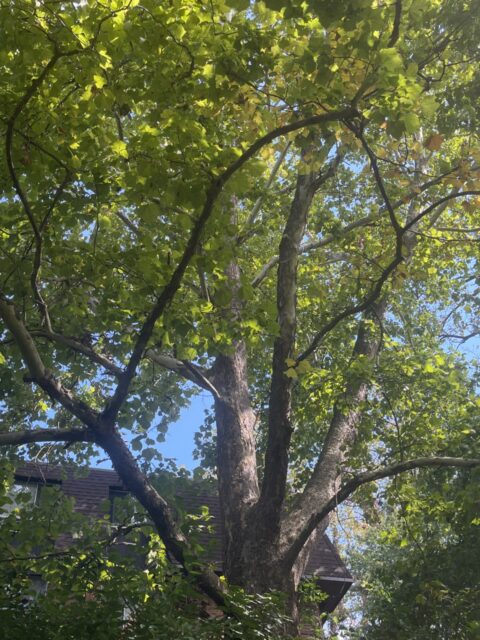
The American Sycamore tree, appears with a wide trunk and a large, dome-shaped canopy. Sycamores have the largest trunk diameter of any tree in the United States. The leaves on a sycamore tree have 3-5 lobes and toothed edges, in winter, sycamore trees are easy to spot due to the brown balls hanging from bare stems. The large CC value (7) of this plant is explained by its habitat preference. The native habitat of the American sycamore is the wetland and riparian zone, or the interface between land and a stream or river. Its inhabits a vast range, extending across the eastern U.S. and stretching south into northern Mexico and north into Canada. According to the book”Wood and Log Characteristics Affecting Veneer production” explains the import usage of this large and fast growing tree. The plant has been used for butcher’s blocks, furniture, veneer and interior trim, boxes and crates, flooring, and particle and fiberboard.
Tulip Tree (Liriodendron tulipfera), 6
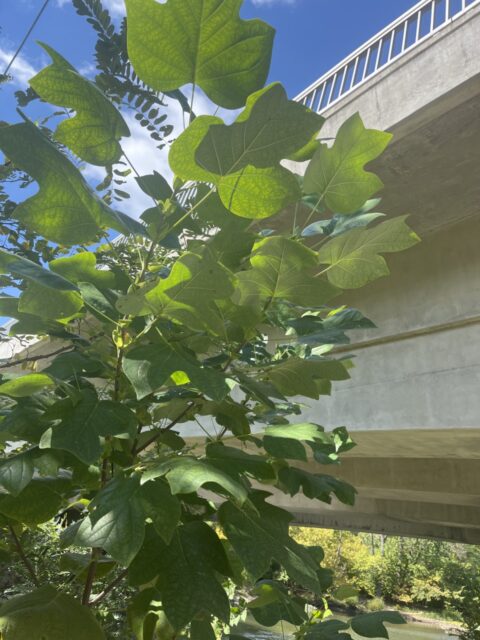
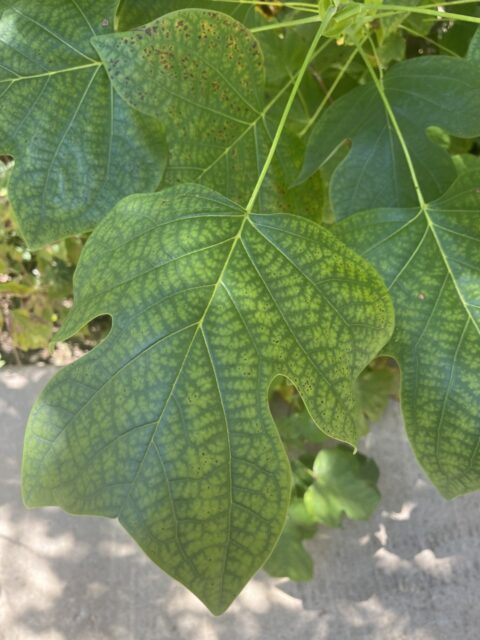
The Tulip Tree is characterized by six petals that are yellow-green on the outside, and orange-yellow on the inside. Its three large sepals are reflexed at the base of the flower, and the interior light-yellow cone of reproductive structures on this perfect flower later becomes the cone-shaped fruit.
The high relatively high CC value (6) of the plant is explained by its habitat preference. It grows very rapidly in deep, rich well-drained soils with uniform rainfall. This plant is the largest and most valuable hardwoods of eastern North America. Furthermore, Tulip Tree is insect and disease free. It is intolerant of compacted soil and should not be placed in confined beds or planters near pavement. According to the research paper, “Liriodendron tulipifera” this plant is used for making furniture, cabinetry, musical instruments, and wood veneer.
Four of my lowest CC species:
American Hackberry (Celtis occidentalis), 4
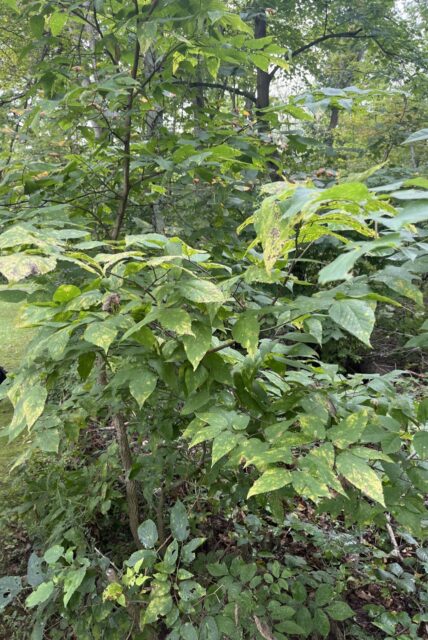
The American Hackberry grow as tall as they do wide, reaching up to 40 to 60 feet in height and width with a crown spread. Their most notable identifying feature is the knobby and warty bark, unlike any of the other trees in our forest. The leaves are asymmetrical, toothed, and longer than they are wide shaped. Features leaves shaped like spearheads, approximately 2–4″ and 1½–2″ wide, arranged alternately along the twigs. Occurs in moist woodlands, in bottom lands, and in uplands, nearly statewide.The American Hackberry prefers moist bottom soil situations, it will grow on any moist, fertile area these factors all contribute to the low CC value (4). Interestingly, Native Americans valued common Hackberry for medicinal, food, and ceremonial purposes. According to the article, “Chemical and Physical Characterization of the Hackberry (Celtis australis) Seed Oil: Analysis of Tocopherols, Sterols, ECN and Fatty Acid Methyl Esters” the bark contains high antioxidants that was decocted to serve as a gynecological aid that could induce abortion, regulate menstrual cycles.
Black Cherry (Prunus serotina), 3

Black cherry is a large, native tree found in the Midwest and throughout the eastern United States. Black cherry is characterized by having alternate simple leaves, two to seven inches long, uniformly wide to lance-shaped, pointed at the tip, and inward curving tip of the leaf. The upper surface of the leaf is dark green and shiny, the lower surface is paler in color. The mature bark is dark and often flipping up on the edges of the plant.Its habitat explains the low CC value for this plant which is 3. Interestingly, the article “Wood Use in the American Furniture Industry” Black cherry wood is a rich reddish-brown color and is strong, hard, and close-grained one of the most valued cabinet and furniture woods in North America.
Black Locust (Robinia pseudoacacia), 0
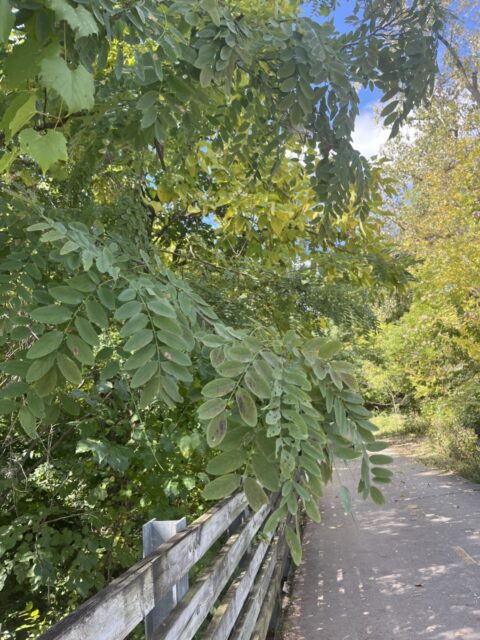
Leaves of black locust leaves are pinnately compound and alternate along the stem and are composed of 7-to 21 leaflets. Leaflets are oval to round in outline, dark green above and pale below. Fragrant white flowers appear in drooping clusters in May and June and have a yellow blotch on the uppermost petal. The flowers are colored cream white with an yellow region near the center and loosely hang in clumps. Interestingly the article “A Rare Ingestion of Black Locust Tree” talks about the bark, seeds, and leaves of black locust trees contain poisonous compounds. They are toxic to both livestock and humans and have been reported to cause symptoms in the nervous system. The low CC value (0) due to its habitat preferences as it develops and grows best in cove or mixed mesophytic forests of the central and southern Appalachian Region. These forests are usually highly productive and characterized by a large and variable number of species. thus, this plant can be found in almost everywhere in the US.
Virginia Creeper (Parthenocissus quinquefolia), 2
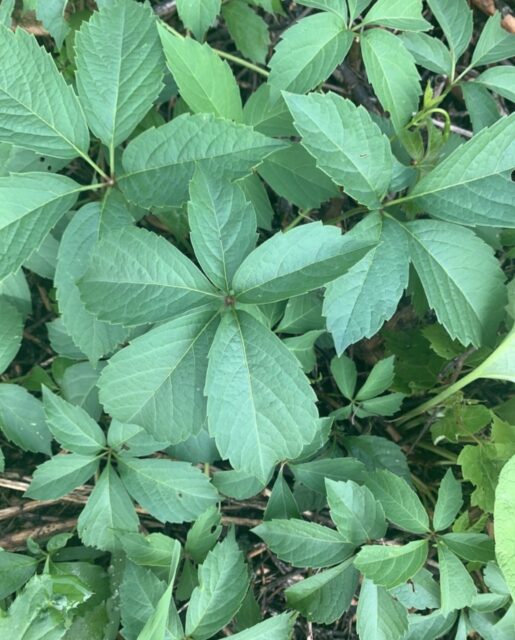
The woody, dedicuous vine, Virginia Creeper can be high-climbing or trailing, 3-40 ft. The leaves of this particularly interesting plant are a dull green on the upper surface and light green below. The undersides may be smooth or hairs. It’s leaves contain 5 leaflets, occasionally 3 or 7, radiating from the tip of the petiole, coarsely toothed, with a pointed tip, and tapered to the base, up to 6 inches long. They remain attractive through the summer, and in the autumn turn bright purple or red before falling off the vines. It is one of the earliest vines to color in the fall. The low CC value s(2) is due to the plants soil and woodland preference, often growing up trees or telephone poles on woodland borders, or in open areas such as along railroad right of ways, banks of streams or lakes, and in disturbed habitats in both rural and urban areas. Interestingly, the article “Effect of Different Auxin Concentrations on Virginia Creeper (Parthenocissus quinquefolia) Rooting” talks about its berries of this plant contain oxalic acid, which is poisonous to humans and other mammals, and may be fatal if eaten.
Four invase plants:
Tree-of-Heaven (Ailanthus altissima)
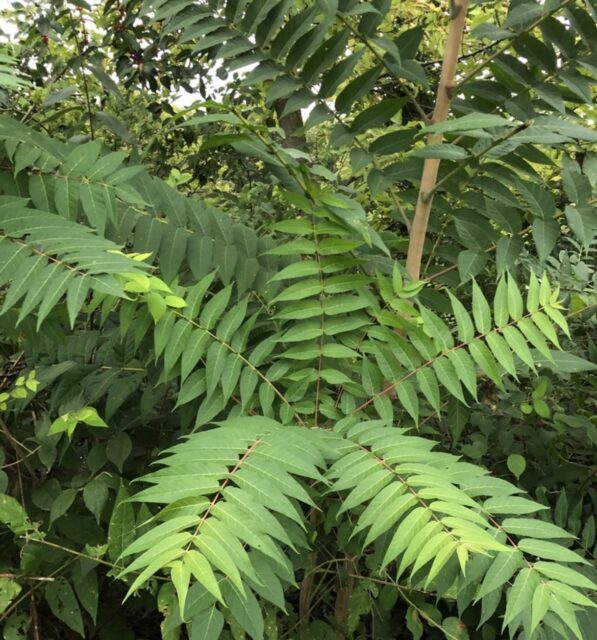
The Tree-of-heaven has smooth, gray bark with chestnut brown twigs. It’s leaves are large, pinnately compound, growing to be one to four feet in length, and contain between 11 and 25 smaller leaflets. The bark of tree-of-heaven is smooth and brownish-green when young, eventually turning light brown to gray. Tree-of-heaven grows almost anywhere but prefers partly shaded, alluvial soils along rivers and streams. The article “Tree of Heaven: An Exotic Invasive Fact Sheet” mentions that the plant was named after its rapid growing ability and it refers to the plant tendency to rapidly grow toward the sky.
Winter Creeper (Euonymus fortunei) 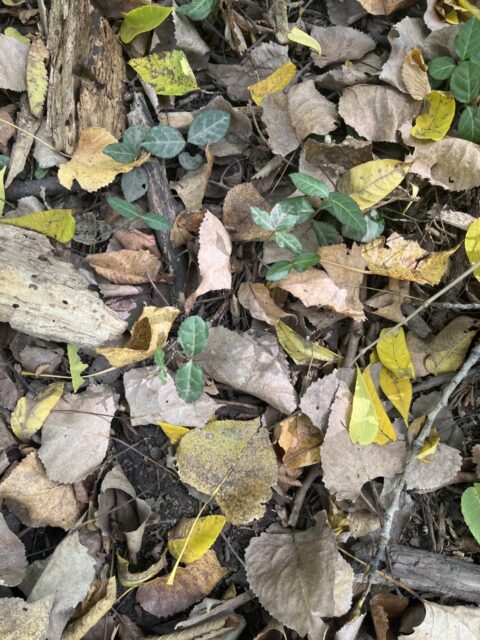
This plant is highly invasive as it It grows across the ground, displacing herbaceous plants and seedlings and climbs trees high into the tree canopy by clinging to the bark. Forest openings, caused by wind, insects or fire are especially vulnerable to invasion. The plant is a evergreen woody vine or sprawling shrub with stems that are green when young. The flowers form in clusters and each flower is quarter inch across with four white to green petals in early summer. The fruits, also quarter inch diameter, hang in clusters and have pink to white coats that split open in mid-to-late fall revealing orange fruit. Interestingly, the article “Floristic Inventory of Woollen’s Gardens Nature Preserve,Indianapolis, Marion County, Indiana, USA, With QuantitativeIndianapolis, Marion County, Indiana, USA, With QuantitativeVegetation Sampling of Permanent Plots in 2003 and 2016Vegetation Sampling of Permanent Plots in 2003 and 201” talks about the important usage of this plant. It can be used as a ground cover, as erosion control, or even as a living fence material. The climbing up vines create a green roof on a pergola, and it’s surprisingly easy to care for.
Amur Honeysuckle (Lonicera maackii)
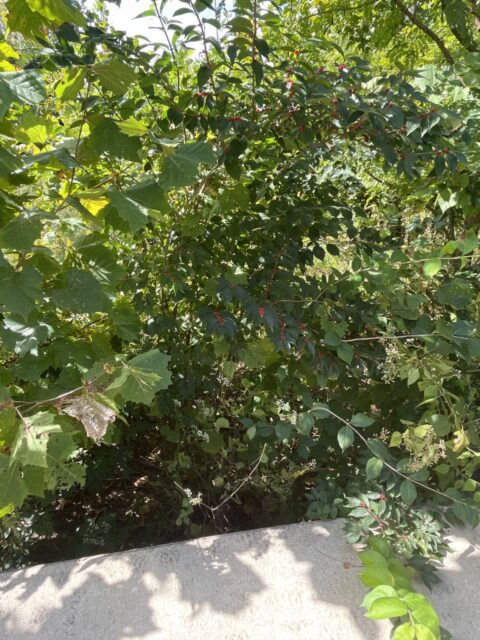
The Amur Honeysuckle has an interesting appearance as the plant is upright, deciduous shrub up to 15-20 feet high. It’s pith of mature stems is hollow and white or tan. The plant’s leaves are opposite, ovate with a tapered tip, lightly pubescent, and up to 3 and a half inch long. It occurs in disturbed habitats including forest edges, forest interiors, floodplains, old fields, pastures, and roadsides. Interestinlgy, the article “Controlling Non-Native Invasive Plants in Ohio Forests: Bush Honeysuckle” mentions that the Amur honeysuckle was planted as an ornamental in New York in the late 1800s and has been widely planted for wildlife and erosion control.
White Mulberry (Morus alba)

The White mulberry is a medium-to-large fast-growing deciduous tree up to 40 feet tall with a rounded crown roughly equal in spread to its height. Leaves are often variable in shape and divided into three to five lobes. Fruit maturing white in late spring. It invades old fields, urban lots, roadsides, and forest edges. Furthermore, it invades forest edges and disturbed forests and open areas, displacing native species. Intrestingly, the article “Energy and Nutritional Properties of the White Mulberry” mentions that the White Mulberry is good source of iron, vitamin C, and several plant compounds and have been linked to lower cholesterol, blood sugar, and most importantly cancer risk. Furthermore, the berries of this plant have also been used in Chinese herbal medicine for thousands of years to treat various illnesses.
Four Substrate -Associated Species:
The following plants are substrate savvy. These plants were also mentioned in Jane Forsyth’s “Geobotany” article. Since the site where I conducted my botanical survey is composed of limestone layer, I chose the following plants to further investigate.
American Hornbeam (Carpinus caroliniana)
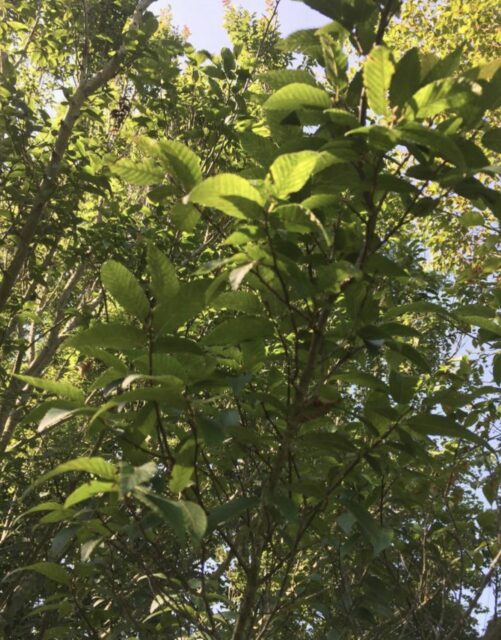
American hornbeam is native to most of the eastern United States and extends into Canada in southwest Quebec and southeast Ontario. It’s habitat includes Shaded woods, Stream, river banks, Flood plains, bottomlands. The Olintangy River soil is preferred by this plant. The soil here is around pH6.8-7.2. This plant is a small, slow-growing, understory tree with an attractive natural, rounded form growing 15-30 feet tall and wide. It has smooth, gray trunk and larger branches of a mature tree exhibit a distinctive muscle-like fluting.
Eastern Redbud (Cercis canadensis)
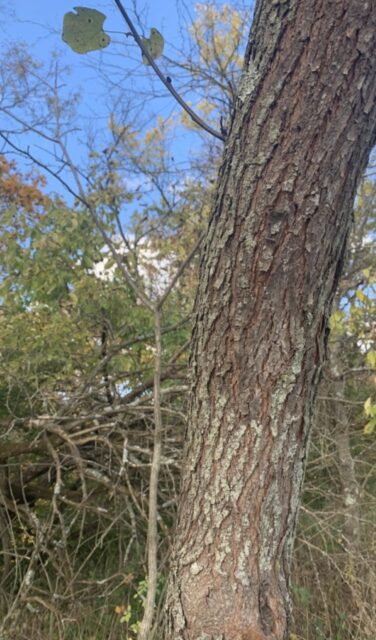
Eastern Redbud occurs in the forest understory in moist rich woods, along the banks of streams, in ravines, on bluffs, in open rocky woods, and abandoned farmlands.It is tolerant to a wide range of soils and pH. However, according to the “Geobotany” article, redbud grows best in soils rated neutral to mildly alkaline (pH 6.6-7.8). Eastern Redbud is widely cultivated as an ornamental because of the plants showy springtime flowers and beautiful heart-shaped leaves.
Chinkapin Oak (Quecus Muehlenbergii)
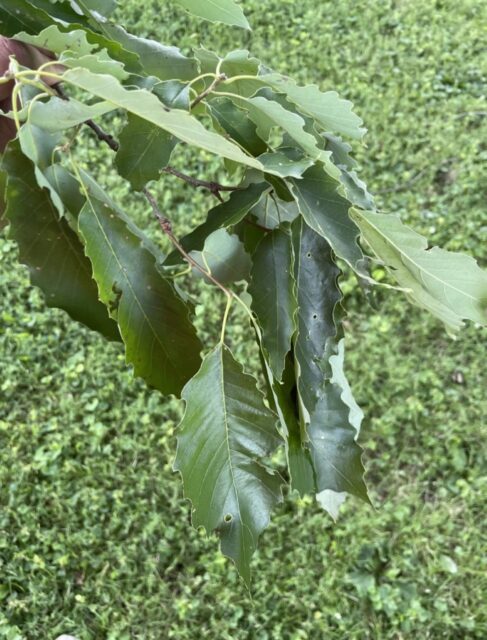
Chinkapin oak is native to the Midwest, including Ohio where it is often found as a specimen planting or as part of a grouping of trees in parks and large areas. Chinkapin oaks are found on dry, limestone outcrops in the wild and perform well in alkaline soils.It also grows on in acidic, alkaline, loamy, moist, sandy, well-drained, wet and clay soils so it has a wide range of distribution in the Midwest. Its glossy, coarsely-toothed leaves are yellow-green and small compared to most oaks. Its lobe tips usually more rounded. Furthermore, the plant leaves usually have 10-14 secondary veins on each side. The lobe tips usually more pointed, often angled forward.
American Hackberry (Celtis occidentalis)
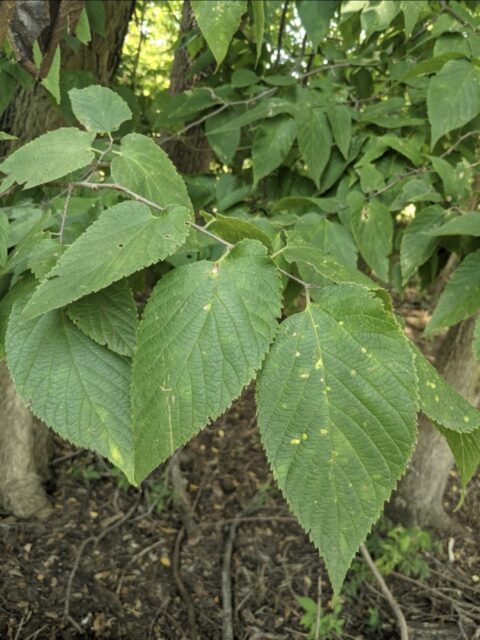
My last choice of substrate-specific plants was the American Hackberry. This plant occurs in moist woodlands, in bottomlands, and in uplands, nearly statewide. Hackberry prefers moist bottom soil situations and soils high in limestone, it will grow on any moist, fertile area. The article mentions that this plant is common in floodplain ares such as the unglaciated Ohio. As a result, the Olentangy River substrate with pH of 6.8-7.2 is a perfect fit for this plant. Hackberry leaves have a recognizable ovate and lanceolate shape with serration along the entire margins.
